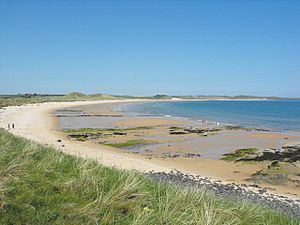North Northumberland Coastal Plain facts for kids

The North Northumberland Coastal Plain is a special natural area found on England's northeast coast, right next to the North Sea. It's a long, narrow strip of land. To its west, you'll find the Cheviot Fringe, the Northumberland Sandstone Hills, and Mid Northumberland. To the south, it connects with the South East Northumberland Coastal Plain.
This coastal plain is part of the county of Northumberland. It's recognized as Natural Area No. 1 and National Character Area 1 by Natural England. This is a group that advises the UK government on nature. The area is about 70 kilometers (43 miles) long and 3 to 10 kilometers (2 to 6 miles) wide. It stretches from the Scottish Border down to Amble on the River Coquet.
Contents
What Makes This Coast Special?
This area is low and often windy, offering wide views of the sea to the east and the Cheviots hills to the west. The coastline itself is very diverse.
Northern Coastline
The northern part of the coast has dramatic, high cliffs. You can see amazing rocky headlands and even islands just offshore. This is known as a 'hard' coast because of its strong, rocky features.
Southern Coastline
Further south, the coast changes. Here, you'll find wide, sandy bays that curve gently. Behind these beaches are sand dunes and flat areas covered by the tide. There are also saltmarshes, which are grassy areas flooded by seawater. This part is called a 'soft' coast because it's made of sand and mud.
Life on the Plain
Away from the coast, the land is mostly used for farming. Farmers grow many different crops here. The landscape is quite open with few trees. However, along the rivers and close to the coast, you'll find more woodlands. There are also areas of permanent grass or natural grassland.
Protected Areas
About a quarter of this coastal plain is a protected area. It's part of the Northumberland Coast Area of Outstanding Natural Beauty. It's also part of the North Northumberland Heritage Coast. These titles mean the area is special and needs to be looked after.
Important Natural Sites
The North Northumberland Coastal Plain is home to several important natural sites. These places help protect wildlife and habitats.
- Special Areas of Conservation (SACs): There are four SACs here. These include the Berwickshire and North Northumberland Coast SAC, Newham Fen SAC, River Tweed SAC, and Tweed Estuary SAC. These areas protect important habitats and species.
- National Nature Reserves (NNRs): You can find three NNRs in this region. They are Lindisfarne NNR, Farne Islands NNR, and Newham Bog NNR. These reserves are managed to protect nature.
- Sites of Special Scientific Interest (SSSIs): There are 15 SSSIs in the area, covering about 1,296 hectares (3,200 acres). These sites are important for their plants, animals, or geology.
Major Rivers
Several important rivers flow through or border this region:
- The River Tweed: The lower part of this river forms the border with Scotland in the north.
- The River Coquet: This river is found in the far south of the plain.
- Whiteadder Water
- The River Aln
Historic Places to Explore
The North Northumberland Coastal Plain has a rich history, with many old and interesting sites.
Holy Island of Lindisfarne
The Holy Island of Lindisfarne is a very important historical place. It has a long history and is home to Lindisfarne Castle. This island is famous for its religious past and beautiful scenery.
Famous Castles
You can also find several impressive castles along this coast:
These castles stand as reminders of the region's past. They offer a glimpse into the history of Northumberland.

